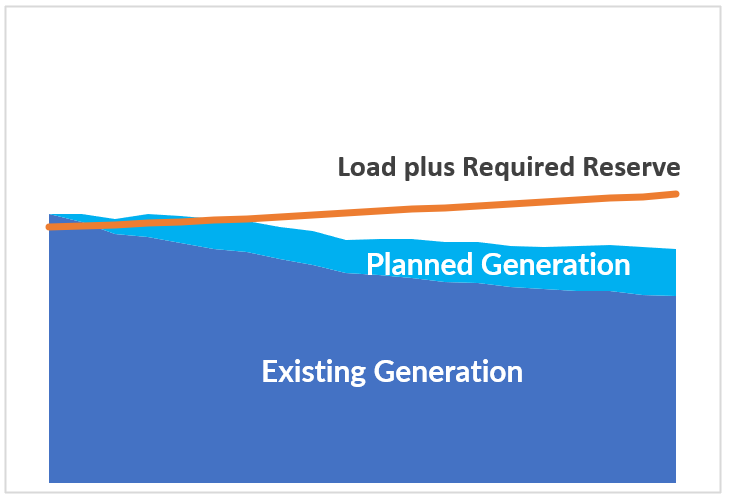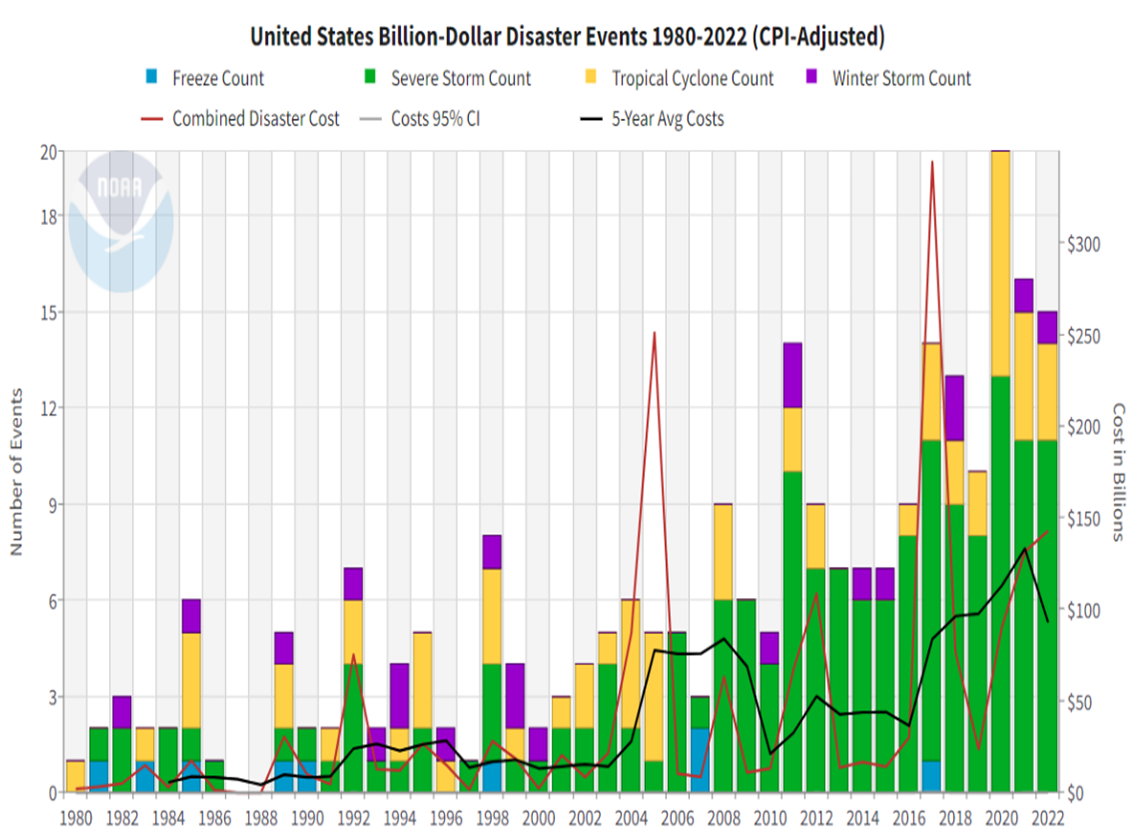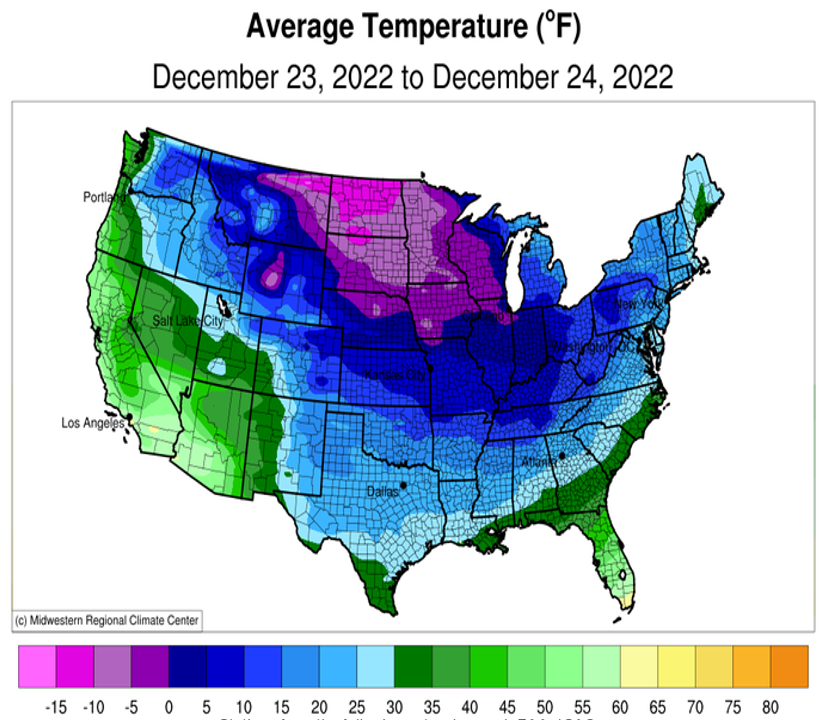Managing uncertainty has always been a central part of electric grid operations, but today’s risks to reliable operations look very different than just a few years ago. Understanding and addressing these risks is vital to meeting our reliability imperative—a responsibility shared by grid operators, utilities, and states to ensure reliability of the electricity system.
Over the last several years, penetration of weather-dependent generation resources has been growing at a rapid rate while dispatchable generation is retiring, as shown in Figure 1. While this brings benefits, including reduced emissions and lower energy production costs, we are also seeing a trend toward reduced resource availability even as load requirements are growing.
Figure 1. Estimated Accredited Capacity and Load in the MISO Region, 2022-2041

Based on publicly announced plans, the region faces a potential capacity risk.
Source: MISO Regional Resource Assessment
Simultaneously, extreme weather events are rising in frequency, intensity, geographical scope, and duration. The National Oceanic and Atmospheric Administration (NOAA) shows an ongoing rise in major weather-related events, as shown in Figure 2. Additionally, today’s severe weather events impact large geographic areas, reducing the ability to rely on electricity imports and exports.
Figure 2

Over the last 40 years there has been an upward trend in major weather events.
Source: National Oceanic and Atmospheric Administration’s National Centers for Environmental Information
These uncertainties create unprecedented challenges for electric grid operations, making it critical that we not only grow our understanding of those challenges, but rapidly evolve our processes and procedures to manage the uncertainty and variability inherent in the evolving energy landscape.
Some Recent Experience with Extreme Winter Weather Events
MISO and other grid operators have experienced firsthand the complexities that come with predicting and managing extreme weather events, experiencing four winter storms in the last five years, as well as hurricanes and summer heat waves. The two most recent winter storms—Winter Storm Uri in February 2021 and Winter Storm Elliott in December 2022—demonstrate the complexities inherent in planning for and managing extreme weather operations.
The two storms shared key similarities—both were severe winter storms affecting large portions of the central United States with extremely cold temperatures, as shown in Figure 3, driving very high electricity demand, high levels of unplanned outages, and transmission congestion challenges. However, there were several key differences that affected operations.
A major difference was in wind output. Winter Storm Uri was a high-pressure system that led to significantly reduced wind output—less than 5 GW in MISO’s region—for multiple days, while Winter Storm Elliott was a low-pressure front that created higher-than-normal wind output of about 19 GW for most of the storm. Additionally, Winter Storm Uri lasted for a week while Winter Storm Elliott created severe conditions for about two days. Assistance to neighboring regions was also unique during Winter Storm Elliott, as MISO had sufficient capacity for its own needs and also utilized emergency procedures to assist its neighbors.
Figure 3: Average Temperatures Seen Across the United States During Winter Storm Elliott

During Winter Storm Elliott large portions of the country experienced colder-than-normal temperatures.
Source: Midwestern Regional Climate Center, Purdue University
Winter Storm Elliott also created unique situations for operators, such as the complexities in managing congestion we face when experiencing atypical import and export electricity flows. Operational challenges were further compounded because load forecasts across the Eastern Interconnection underestimated load by as much as 9%, primarily because the storm delivered historically cold weather for the month of December compared to 30-year averages and the event came during the Christmas holiday. Historical data did not exist to match these conditions. The under forecasting of load resulted in the need for more long-lead time resource commitments. This allowed MISO and its members to maintain system reliability while exporting energy to support neighboring regions. These actions ultimately resulted in higher uplift payments to market participants.
Evolving Landscape and Needs
The electricity industry has robust severe weather training and operating procedures in place, but we must evolve in areas including the following to keep up with changes in the energy landscape and weather patterns.
- Fuel assurance: During severe winter weather conditions, natural gas supply challenges can arise, as was seen in Winter Storm Elliott, when unplanned gas outages in the MISO region increased by 14 GW from December 22 to December 23, accounting for nearly three-quarters of the storm-related outages. Additionally, as we have experienced in past storms, output from weather-dependent generation resources can vary significantly, depending on weather conditions. The industry can benefit from close coordination with the gas industry and improving forecasting models to better anticipate wind and solar output.
- Load forecasting: Grid operators and utilities are encountering new and challenging conditions that are difficult to predict with existing tools. As an industry, we need to look at potential gaps in data and assess ways to improve load forecasting to prepare for unique system conditions.
- Inter-regional coordination: Neighboring reliability coordinators have always worked together to share energy across regions. However, the frequency and challenges of coordination are growing. We need a clear understanding of and procedures governing how neighboring regions can support each other, how to anticipate and manage congestion, and how to manage pricing in emergency conditions.
- Operational planning: We must look at past events, and better understand how the weather and power system will change going forward to gain better foresight into when our existing tools and procedures might be inadequate and understand how they work together across multiple regions.
- Pricing in emergency conditions: It is important to ensure accurate pricing leading up to and during scarcity and emergency conditions in order to signal system conditions.
Today, the electric industry faces new and growing uncertainties and challenges. By learning from one another and working together, we will successfully navigate this new and evolving era to ensure continued reliability and value for the nation’s electricity consumers.
Jerry Terry & the MISO Operations Team
Senior Advisor, Midcontinent Independent System Operator (MISO), with support from the MISO Operations Team

Leave a Reply